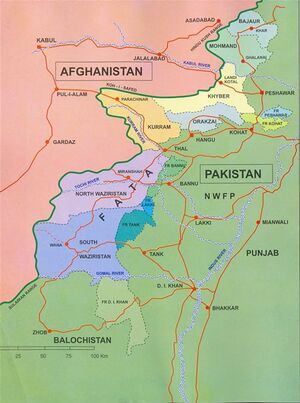Parachinar
| Author:Laxman Burdak, IFS (R) |

Parachinar (Urdu: پاڑاچنار, Pashto: پاړا چنار) is the capital of Kurram Agency, and the largest city of the Federally Administered Tribal Areas of Pakistan.
Location
Parachinar is situated on a neck of Pakistani territory south of Peshawar, that juts into Paktia Province of Afghanistan. It is the closest point in Pakistan to Kabul and borders on the Tora Bora region of Afghanistan.
History
The name Parachinar may derive from a large Chinar tree at a place now encompassed by the headquarters of Kurram Agency. Alternatively, there is in the Kurram Agency a tribe known as the Para-chamkani (Lisyani), which is remembered to have convened meetings under a Chinar tree to resolve their social matters.[1] The previous name, used for Kurram was Tutki, which is still used by some Afghan people. The inhabitants of Tutki were called Tutkiwal.
The Kurram Valley, which is drained by the Kurram River and its affluents, lies to the south of the lofty Safed Koh range, and reaches from Thal in Kohát to the Peiwar Kotal on the borders of Afghán Khost.
The people are Pathans of various clans, the predominant element being the Turis, who are Shias by religion and probably of Turkish origin. It was at their request that the valley was annexed in 1892. The political agent has his headquarters at Parachinar in Upper Kurram, which is divided from Lower Kurram by a spur of the Khost hills, through which the river has cut a passage. Such part of the Indian penal law as is suitable has been introduced, and civil rights are governed by the customary law of the Turís (Turizona). Upper Kurram is a wide and fertile valley set in a frame of pine-clad hills. It is not fully cultivated, but has great possibilities, especially in the matter of fruit growing. The snowfall is heavy in winter, but the summer climate is excellent. Lower Kurram is a poor and narrow glen unpleasantly hot and cold according to the season of the year. Parachinár is connected with the railhead at Thal by a good road.
Parachinar originated as a summer residence for nomadic tribes who wintered their livestock at lower altitudes, and the district had originally been a summer residence for Moghul emperors from Delhi. The Parachinar region was part of Durrani empire before the Second Afghan War of 1878-79, but was not firmly annexed by the British until 1892. During the colonial era and 1947, Parachinar became a hill station for people from Peshawar; as it is relatively cool in the summer and very easy to reach from the plains despite its high altitude since there are no steep ascents on the route from Peshawar.
Because of its proximity to the border of Afghanistan, in recent years, the economy of Parachinar has been adversely affected, with tourism in steep decline.
Parachinar has four seasons. Parachinar is very famous for its fresh fruits and fresh vegetables.
Tribes
Turi, Bangash, Orakzai, Zazai, Mangal and Para Tsamkani are the major tribes and Christian, Hindus and Sikhs are the Minorities of Parachinar.
Notable persons
External links
References
Back to Jat Places in Pakistan

